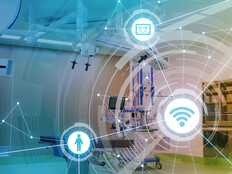How is 5G Technology Changing Healthcare?
During a yearly checkup, would you rather:
Sit in a waiting room reading outdated magazines while strangers cough around you?
Virtually connect on your tablet and review your vital trends from a fitness-tracking device?
If you chose the first option, you are part of a shrinking minority. In our fast-paced world, even having the time for a checkup is growing antiquated, and a checkup only reflects a person’s health at a very specific point in time.
What if, instead, a person’s actions, vital statistic trends and other data — collected via Internet of Things–connected devices — could be stored in a health profile and intelligently fed to a provider in a secure fashion? With this degree of insight, physicals would be more than just 30-minute snapshots into a patient’s health, where the patient might be untruthful about their recent health history. Instead, thanks to the advent of 5G and with the help of connected devices such as laptops, tablets or phones, doctor visits could become informed, data-driven discussions about year-over-year health.
MORE FROM HEALTHTECH: Don't miss out on our must-read health IT bloggers list!
5G Makes Smart Data and Smart Devices Effective Healthcare Tools
The speed, bandwidth and device connectivity promised by 5G and the cellular transformation will lay the groundwork for providers to reimagine how the industry approaches wellness. By collecting smarter streams of data — rather than single points in time — and leveraging artificial intelligence, healthcare providers and patients can follow trends, detect changes and identify concerns earlier and more accurately than ever before.
Moreover, as the health industry drives toward more personalized care, 5G can help to incorporate more data points into a care decision, likely making the results more impactful.
The challenge is that right now, the industry is at a crossroads: While there is an unprecedented amount of data available, providers are not yet able to use that data in the most relevant and meaningful way. To meet the needs of a rapidly changing world, we need an underlying network that can power the speed of connection with the breadth of data. 5G promises to provide that infrastructure and push smart devices and decisions from the core to the edge, creating secure, smarter data streams and enabling greater personalization.
MORE FROM HEALTHTECH: How 5G and IoT can enhance the patient care paradigm.
5G Helps to Enable Care from Anywhere for Patients
The greater use of data-generating tools, made more effective, efficient and secure by 5G, could have wide-reaching impacts. Take at-home senior care, for example: IoT sensors could indicate when an elderly patient is awake, what their activity and food intake levels are and whether they have taken their medications. If a senior has a chronic condition, a connected system can also record vital trends on a rolling basis, meaning that those who monitor the patient’s vital signs — whether that’s a parent, doctor or other caretaker — can ensure that the patient is doing well from anywhere in the world.
Patients also benefit directly from these capabilities. At the first sign of illness, daily wellness check-ins and consults increase the likelihood of an early diagnosis, resulting in faster treatment and reduced risk of a secondary infection.
Moreover, when it comes to clinical care, if an elderly patient needs to consult a specialist who isn’t available locally or in a timely fashion, the physician can leverage videoconferencing technology to engage the patient and share trends and diagnostic information.
While some of these capabilities are available today, 5G makes them more ubiquitous, reliable and immediate.
5G Improves Outcomes and Access for Healthcare Providers
Providers can also see benefits from 5G. The technology can help the provider improve follow-up practices via virtual visits and monitoring, which can translate to reduced readmission rates. If a patient in need of rehabilitation is asked to perform regular exercises by their healthcare provider, they are much more likely to follow that regimen if a nurse has access to smart data that indicates whether or not the patient has performed the exercises, and can check in via video chat.
Rural regions, in particular, can benefit from these types of innovations, as ongoing wellness checks and virtual engagement programs can reduce the costs of care. Thanks to 5G, rural hospitals can have access to virtual top shelf resources when needed, allowing them to better serve their communities and compete for patients’ healthcare dollars.
Further, smart technology and 5G can blur the walls between the hospital and the home, better managing the care of long-term patients who require the most resources from the healthcare system.
Ultimately, the advent of 5G is an exciting new horizon for healthcare that can help power personalized, smarter care capabilities and elevate connected medicine to an unprecedented level. Better healthcare means more than just cutting costs and providing improved service; at the end of the day, it is about letting patients’ voices be heard, finding new opportunities for hope and allowing individuals to live longer and more productive lives.










